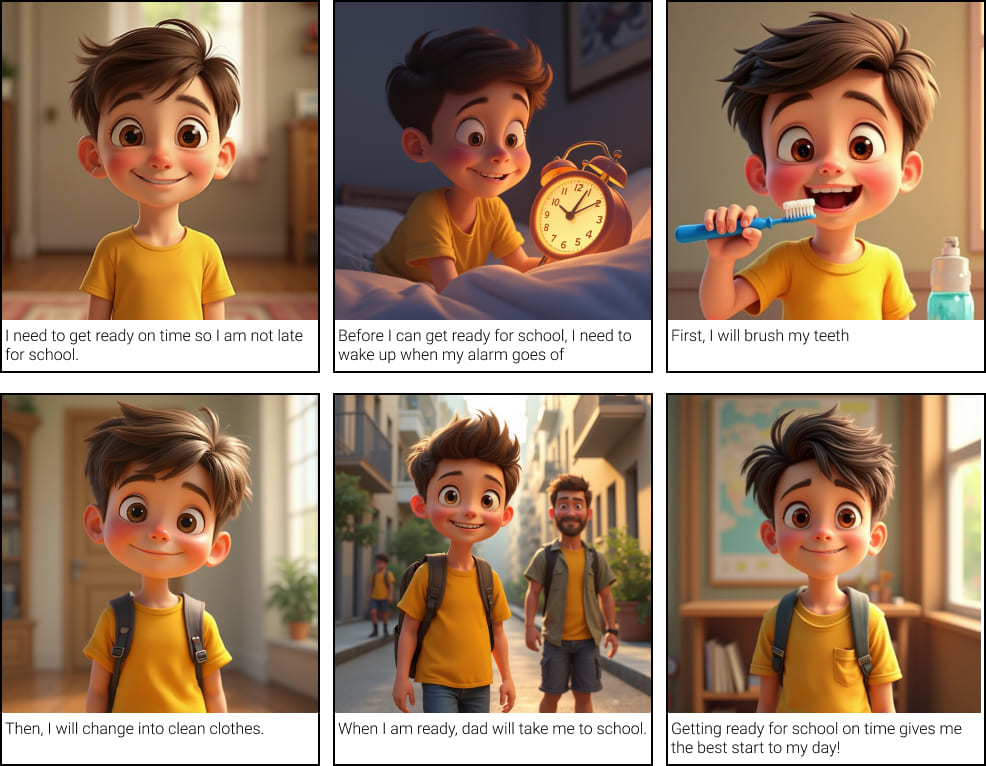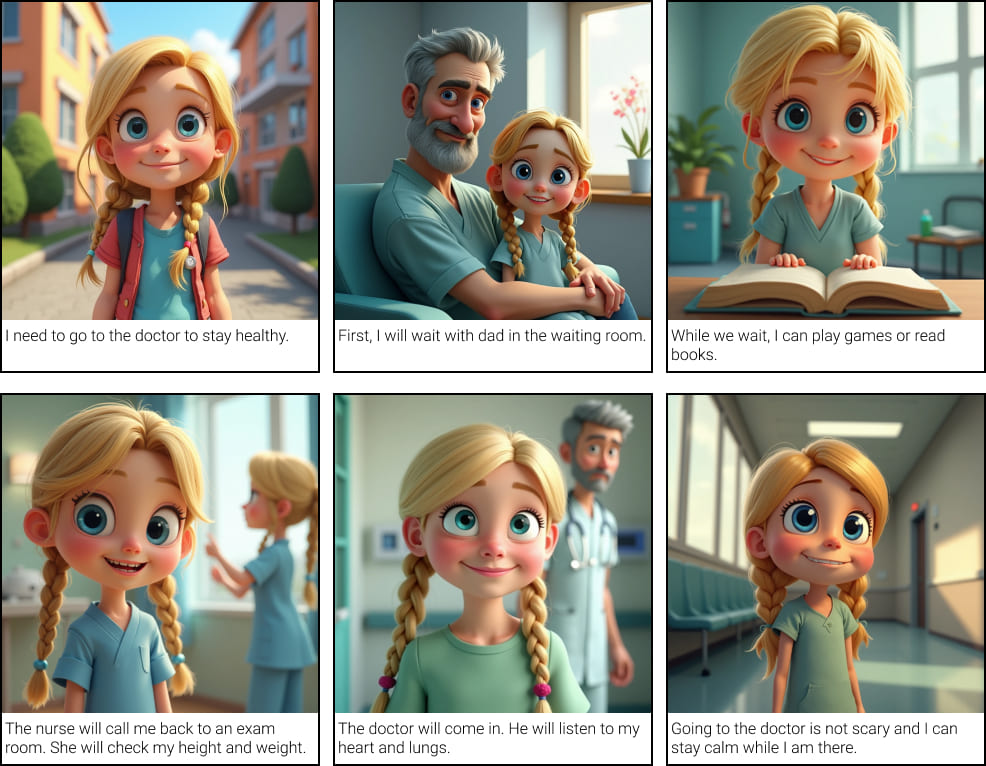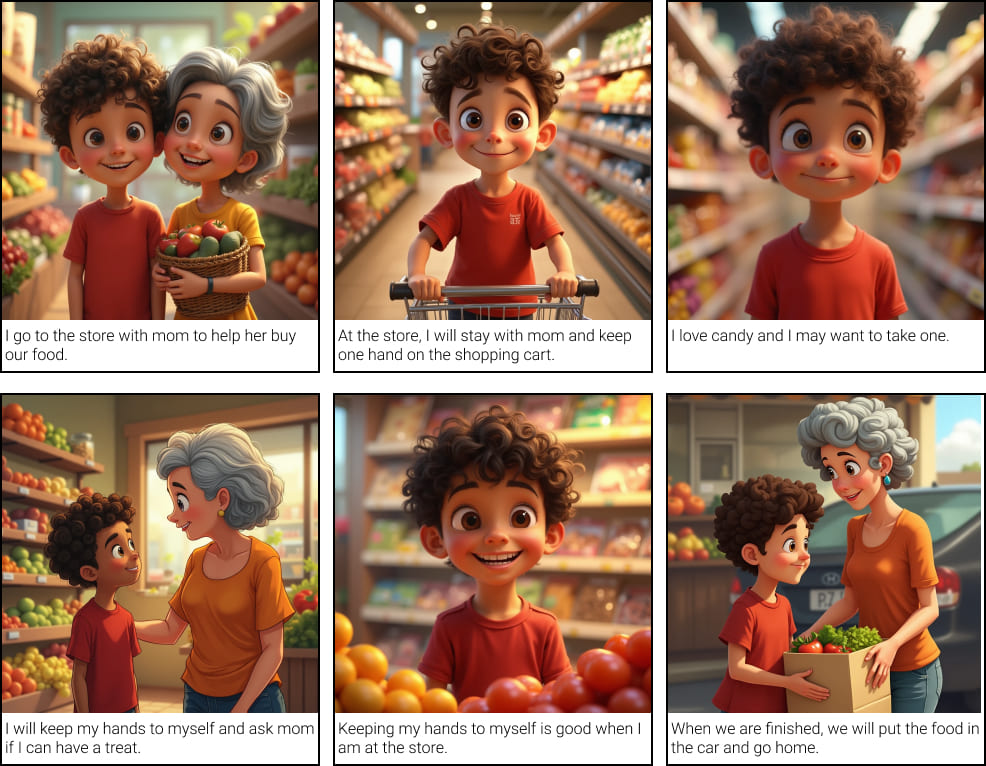Social Stories for Kids with Autism (With Examples and Tips)
 Natalie Fitzgerald
Natalie Fitzgerald SLP
08/13/24 | Last modified: 10/02/24

Social stories are narratives that are used to help children with autism navigate situations that they may find difficult. Social stories for kids with autism are typically written from the child’s perspective. These stories describe what will happen, why it happens, and what the child can do, providing a clear and structured way to navigate social situations.
When used correctly, social stories can be very beneficial for autistic children in a wide variety of situations, such as doctors’ appointments, daily routines, making friends, and more. In this review, we will provide examples of social stories for kids with autism targeted at a variety of age groups and ability levels.
What are Social Stories for Autism?
Social stories were developed by Carol Gray in 1990 as a tool to improve the social understanding and communication skills of children with autism. Children with autism commonly have a hard time navigating social situations, and this can be caused by a variety of reasons including anxiety, communication breakdowns, sensory difficulties, or differences in social communication style.
For example, many autistic children experience difficulty transitioning between activities at school, such as stopping computer time to begin a new lesson. Social stories can help by preparing the child for the transition by explaining what will happen and setting clear expectations. Other times, children may experience heightened anxiety about doctors’ appointments, and social stories help here in a similar capacity by explaining why we go to the doctor and walking children through the process of the appointment.
In addition to clear language, pictures are an important component of social stories for students with autism. The pictures used in stories can be cartoon images, images of real children in the situation, or images of the child the story is made for. The type of image used is dependent on the child and what is most beneficial for them.
Why Social Stories for ASD Are Important?
Social stories for ASD are important because they help people prepare for difficult life situations in a variety of ways:
- Enhancing understanding of social cues: Social stories provide clear and concise explanations of social situations, helping individuals with autism understand social cues and expectations.
- Reducing anxiety: By describing what to expect in different scenarios, social stories can alleviate the anxiety and stress that individuals with autism often experience in unfamiliar or unpredictable situations.
- Behavior Management: When considering behavior interventions for kids with ASD, social stories are often a top choice. Social stories can address and help correct specific behavioral issues by illustrating the sequence of events, expectations, and promoting positive behaviors throughout the situation.
- Increasing predictability: Social stories use visuals to outline the sequence of events in specific situations, making the environment more predictable and manageable for autistic individuals.
- Facilitating communication: By using visuals and simple language, social stories facilitate communication for children who may have language delays or are non-speaking, which can reduce communication breakdowns for unfamiliar situations.
- Promoting independence: By providing strategies and scripts for handling various situations, social stories empower individuals with autism to navigate social interactions more independently.
Key Components of a Social Story for Autism
Social stories typically follow a predictable structure, though the length and complexity will vary based on the age and/or abilities of the child. In essence, all social stories will contain the following components:
- Introduction: Introduce the topic of the story (ex: Going to the Dentist).
- Goal: Why this social story is important (ex: We go to the Dentist to keep our teeth healthy.)
- Descriptive sentences: Present factual information to describe what happens during the event (ex: I will sit in a chair. They will look in my mouth.)
- Perspective sentences: Describe the feelings or thoughts of the child in the story (ex: I do not like the light that shines in my eyes.)
- Directive sentences: Suggest different positive behaviors the child can follow (ex: I can wear my sunglasses so it is less bright.)
- Affirmative sentences: Reinforce the importance of the situation and affirm their ability to handle it (ex: It is good to have clean, healthy teeth.)
In addition, sentences are usually accompanied by visuals to help reinforce the message. For example, the sentence “I can wear my sunglasses so it is less bright.” can be accompanied with a picture of the child wearing their own sunglasses.
Social Story Examples
The following social story examples were created for a variety of ages to target situations that arise in most childs’ lives. These situations are more specific to kids with autism, but are not limited to this population.
Getting Ready for School

Age: 5-10 years
Introduction: I need to get ready on time so I am not late for school.
Goal: I will be ready for school by 7:20 am.
Before the situation: Before I can get ready for school, I need to wake up when my alarm goes off.
During the situation: Use the various sentence types to guide the child through the story.
- Descriptive sentence: I need to get ready before I can go to school.
- Directive sentence: First, I will change into clean clothes.
- Perspective sentence: I may not like the shirt mom picked out, but I can ask for a different one.
- Directive sentence: After my clothes are changed, I will brush my teeth.
- Perspective sentence: I do not like brushing my teeth.
- Directive sentence: I will brush my teeth with help from mom to keep them clean.
- Affirmative sentence: It is good to keep my teeth clean.
- Descriptive sentence: When I am ready, dad will take me to school.
- Affirmative sentence: It is important to arrive on time for school.
After the situation: When I get ready on time, I am not late to school and will not miss breakfast.
Conclusion: Getting ready for school on time gives me the best start to my day!
Going to the Doctor

Age: 4-10 years
Introduction: I need to go to the doctor to stay healthy.
Goal: I will stay calm while I am at the doctor.
Before the situation: Before I go to the doctor, I will read my story and get my favorite stuffed animal.
During the situation: Use the various sentence types to guide the child through the story.
- Descriptive sentence: First, I will wait with dad in the waiting room.
- Perspective sentence: I don’t mind waiting.
- Directive sentence: While we wait, I can play games or read books.
- Descriptive sentence: The nurse will call me back to an exam room. She will check my height, weight, and blood pressure.
- Directive sentence: I will hold still while she checks me.
- Descriptive sentence: The nurse will talk to me and dad. She will listen to my heartbeat.
- Perspective sentence: The stethoscope feels cold and tickly, but it does not hurt.
- Descriptive sentence: The nurse will leave and I will wait with dad.
- Descriptive sentence: The doctor will come in. They will look in my eyes, nose, ears, and mouth. They will listen to my heart and lungs.
- Perspective sentence: The stethoscope feels cold and tickly again.
- Directive sentence: I will answer questions when the doctor asks me things.
- Descriptive sentence: We are finished now and we can go back home.
- Affirmative sentence: It is good to stay calm at the doctor.
After the situation: When I stay calm, the doctor can make sure I am healthy.
Conclusion: Going to the doctor is not scary and I can stay calm while I am there.
Going to the Store

Age: 5-10 years
Introduction: I go to the store with mom to help her buy our food.
Goal: I will keep my hands to myself at the store.
Before the situation: Before we go to the store, I will get my headphones and a toy to hold.
During the situation: Use the various sentence types to guide the child through the story.
- Descriptive sentence: The grocery store is full of food.
- Descriptive sentence: We buy food at the store so our family has good and healthy things to eat.
- Directive sentence: At the store, I will stay with mom and keep one hand on the shopping cart.
- Perspective sentence: The store can be loud and bright.
- Directive sentence: I can wear my headphones so it is not too loud for me.
- Descriptive sentence: I might see one of my favorite foods and want to grab it.
- Directive sentence: I will keep my hands to myself and ask mom if we can get it.
- Descriptive sentence: I will see lots of strangers at the store.
- Perspective sentence: Sometimes, I get scared when strangers talk to me.
- Directive sentence: I will stay close to mom and hold her hand if I feel scared.
- Descriptive sentence: When we have all our food, we will go to the check-out line.
- Descriptive sentence: The check-out line has lots of candy and treats.
- Perspective sentence: I love candy and I may want to take one.
- Directive sentence: I will keep my hands to myself and ask mom if I can have a treat.
- Affirmative sentence: Keeping my hands to myself is good when I am at the store.
After the situation: When we are finished, we will put the food in the car and go home.
Conclusion: Keeping my hands to myself makes shopping better for everyone.
Meal Time
Age: age 4-7 years
Introduction: At meal time we eat together at the table.
Goal: I will stay at the table until I am finished eating.
Before the situation: Before I eat dinner, I need to wash my hands so they are clean.
During the situation: Use the various sentence types to guide the child through the story.
- Descriptive sentence: Mom or dad will tell me when dinner is ready.
- Directive sentence: After they call me, I will come sit in my chair at the table.
- Descriptive sentence: Mom or dad will bring my food to me.
- Perspective sentence: I may not like all the food on my plate, but that’s okay.
- Directive sentence: I will wait until everyone is sitting down to start eating.
- Perspective sentence: I do not like sitting still in my chair for a long time.
- Directive sentence: I will ask if it is ok before I stand up and leave the table.
- Descriptive sentence: Meal time is over when everyone is done eating.
- Affirmative sentence: It is nice to ask before I leave the table during meal time.
After the situation: After I finish eating, I will take my plate to the sink and wash my hands.
Conclusion: Staying at the table during meal times is important to my family.
Bath Time
Age: 2-4 years
Introduction: I need to take baths so I stay clean.
Goal: I will let mom or dad wash my hair.
Before the situation: Before I get in the bath, my clothes and pull-up come off.
During the situation: Use the various sentence types to guide the child through the story.
- Descriptive sentence: Mom or dad will put me in the bath.
- Perspective sentence: I like splashing in the warm water.
- Descriptive sentence: Mom or dad will wash my body.
- Perspective sentence: The washcloth feels a little scratchy.
- Directive sentence: I can play with my bath toys.
- Descriptive sentence: Mom or dad will wash my hair with soap.
- Perspective sentence: I do not like how it feels.
- Directive sentence: I will hold still while they wash my hair.
- Affirmative sentence: Having clean hair is important.
- Descriptive sentence: They will wash the soap away with water.
- Perspective sentence: I like how the water feels on my hair!
- Affirmative sentence: Staying still keeps the soap out of my eyes.
After the situation: After my bath, I get dried off and dressed in my pajamas.
Conclusion: I can hold still and let mom and dad keep my body clean.
Tips for Creating Social Stories for Autistic Children
When creating social stories for autism, there are several factors to keep in mind:
- Keep it personalized: Social stories work best when they are individualized to each child and the specific situations they find challenging.
- Use appropriate language: A story that uses very simple language would probably not be helpful to a middle schooler, whereas a story that doesn’t include pictures would not be appropriate for a preschooler.
- Use real-life scenarios: This may seem like a given, but it is important to create social stories about the real scenarios a child will encounter. If your child has difficulty transitioning from home to the school bus, their story should be about that specific scenario.
- Practice and repetition: Social stories are best implemented when they are read multiple times so children have a thorough understanding of the situation and expectations. Just like you wouldn’t be able to pass a test after attending one lesson, a child cannot be expected to remember all the details if they’ve only read it once.
- Make it interactive: Include questions for the child, open-ended or closed-ended as is appropriate, to keep the child engaged. Examples could include: Is it ok to bite the dentist? What can I do if something hurts?
- Focus on positive outcomes: It is important to always reinforce what the child should be doing instead of what they should not be doing. Keep the tone of the story positive and remind the child that they are capable of handling the situation.
- Encourage independence: One major goal of social stories is to encourage children to handle challenging situations independently. When reading, encourage the child to help brainstorm things they can do so they feel in control, which can help foster independence.
For an additional resource on creating social stories for children, Autism Little Learners has an excellent social stories library you can check out.
Using Forbrain in Social Stories
Forbrain is an innovative auditory feedback device that enhances speech and language skills. It works by using a bone conduction headset to amplify the user’s voice, providing immediate auditory feedback. This feedback can help improve attention, memory, and verbal processing. Forbrain can be used to facilitate a number of therapy interventions, including social stories for autism.
The amplified feedback from Forbrain helps children focus on the narrative and enhances their comprehension and retention. Encouraging the child to read aloud or repeat key sentences while wearing Forbrain can reinforce language skills and ensure they understand the social cues and behaviors described in the story.
Final Words
Social stories are a powerful tool for helping children with autism navigate challenging social situations. By providing clear explanations and setting expectations, these narratives can significantly reduce anxiety and improve behavior in various contexts. When creating social stories, it’s essential to tailor them to the child’s specific needs and use clear, simple language. Stories should be interactive and practiced regularly to build confidence and encourage desired behaviors. Additionally, incorporating tools like Forbrain can further enhance the effectiveness of social stories. Forbrain’s auditory feedback helps children focus and improve their comprehension and verbal skills during story sessions.
By following these guidelines and utilizing social stories consistently, parents and caregivers can help autistic children better understand and navigate the world around them, leading to improved social interactions and overall well-being.
References
Karkhaneh, M., Clark, B., Ospina, M. B., Seida, J. C., Smith, V., & Hartling, L. (2010). Social StoriesTM to improve social skills in children with autism spectrum disorder. Autism, 14(6), 641–662. https://doi.org/10.1177/1362361310373057
Reynhout, G., & Carter, M. (2006). Social StoriesTM for children with disabilities. Journal of Autism and Developmental Disorders, 36(4), 445–469. https://doi.org/10.1007/s10803-006-0086-1
Pierce, R. (2020, December 17). How to write a social story (a step-by-step guide). Life Skills Advocate. https://lifeskillsadvocate.com/blog/how-to-write-a-social-story/
Social Stories. Carol Gray – Social Stories. (2015, November 2). https://carolgraysocialstories.com/social-stories/





